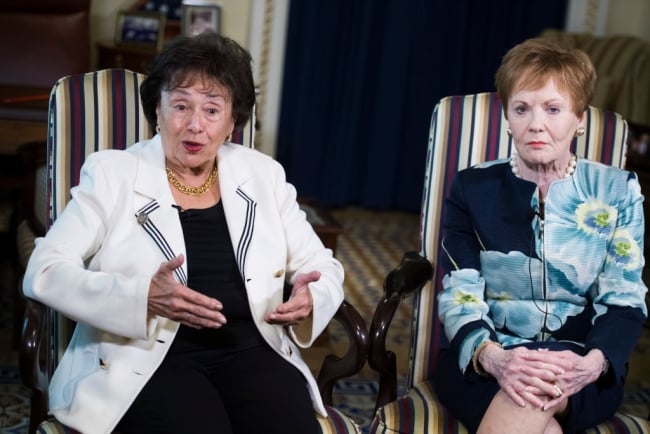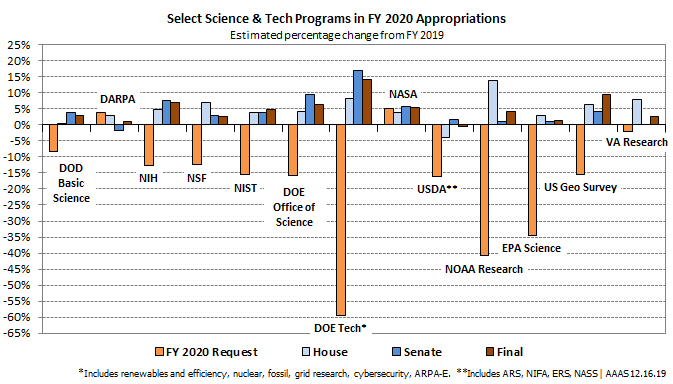You have /5 articles left.
Sign up for a free account or log in.

House Appropriations Committee chairwoman Nita Lowey, D-N.Y., left, and ranking member Rep. Kay Granger, R-Tex.
Getty Images
The U.S. House of Representatives on Tuesday passed a budget bill that would increase spending on higher education programs and scientific research, while ignoring the deep cuts proposed by the Trump administration.
The Senate is expected to pass the budget bill later this week for the 2020 fiscal year and its $2.5 billion increase in spending on higher education programs. President Trump must sign the final bill by Friday to avert a government shutdown.
While the final deal doesn’t include the level of education and research funding increases the Democratic-controlled House had proposed, the bill is still a solid victory for higher education, said Jonathan Fansmith, director of government relations for the American Council on Education.
“These are good increases,” he said. “Everything got something.”
Groups focused on science and research praised the bipartisan budget deal, which included a $2.6 billion, or 6.5 percent, increase for the National Institutes of Health. Likewise, the National Science Foundation would receive an increase of $203 million, or 2.5 percent, under the bill.
The White House in March released a proposed budget that would have slashed basic and applied research expenditures by more than $12 billion, or 14 percent.
The deal comes more than two months into the fiscal year, which the American Association for the Advancement of Science said is not ideal for science programs. But if the budget is finalized, it will be the earliest finish for the federal appropriations process since 2015. (See the below graphic from AAAS on the budget.)
The spending package is a praiseworthy piece of bipartisan legislation that continues the trend of prioritizing investments in the American scientific enterprise, the American Society for Biochemistry and Molecular Biology said in a statement.
“The legislation would make FY20 the fifth year in a row of multibillion-dollar increases, helping the NIH’s budget grow to a record $41.7 billion,” said the society. “Perhaps most importantly, the legislation sets a minimum 3 percent increase in funding at each of the NIH’s 28 institutes and centers. This ensures that research of all kinds, from discovery to clinical efforts, will benefit.”
Congress also agreed to begin funding research into gun violence after lifting a ban that had been in place for two decades. The bill includes $25 million in research funds for gun violence that will be split evenly between the NIH and the Centers for Disease Control and Prevention.
On higher education, congressional leaders largely ignored the budget slashing recommended by Betsy DeVos, the U.S. secretary of education.
For example, the budget deal would increase funding for Supplemental Education Opportunity Grants and Federal Work-Study. Trump’s budget would have eliminated SEOG and cut the work-study program’s funding roughly in half. (See below for higher education-related increases under the bill.)
The budget features a $150 increase in the maximum award for federal Pell Grants compared to the 2019 enacted level. The maximum award would be $6,345 under the bill. A House appropriation document said the increase would help Pell Grants keep pace with inflation.
“Increases in the maximum Pell Grant combined with increases to Supplemental Education Opportunity Grants and Federal Work Study would boost affordability, helping students access and excel in higher education,” Peter McPherson, president of the Association of Public and Land-grant Universities, said in a written statement. “Combined with significant wins for students in the recently passed FUTURE Act, student aid will be both easier to access and will make a modestly increased contribution to the costs borne by students and families.”
The $150 increase to maximum Pell awards would be meaningful, according to Jessica Thompson, director of policy and planning for the Institute for College Access & Success. However, the bill also would cut the Pell Grant program’s reserve fund by $500 million, a move TICAS criticized.
Thompson also noted that the current maximum grant covers less than one-third of the cost of attending a four-year public college, the lowest share in more than 40 years.
“While a $150 increase to the maximum award is certainly welcome, we continue to encourage policymakers to make significant new investments in the Pell Grant program,” she said in a statement, “including restoring an automatic annual inflation adjustment so that appropriators do not have to reach a political deal to plug that gap with limited funds.”
The U.S. Department of Education’s total discretionary appropriations under the bill would be $72.8 billion, which is $1.3 billion more than the 2019 enacted level and $8.7 billion above the White House budget request.
Budget allocations for Education Department programs include:
- $865 million for the Supplemental Educational Opportunity Grant program, an increase of $25 million.
- $1.2 billion for Federal Work-Study, an increase of $50 million and $680 million more than Trump’s budget request.
- $1.1 billion for federal TRIO programs, an increase of $30 million and $140 million above the president’s budget.
- $365 million for GEAR UP, an increase of $5 million.
- $325 million for historically black colleges and universities, $42 million more than the 2019 enacted level and the White House request.
- $143 million for Hispanic-serving institutions, an increase of $19 million.
- $37 million for tribally controlled colleges and universities, an increase of $5 million.
- $53 million for the Child Care Access Means Parents in School program, an increase of $3 million.
- $7 million for the open textbooks pilot program, an increase of $2 million.
- $7 million to restart the Centers of Excellence for Veterans Student Success Program, which the president’s budget did not fund.
- $10 million for Career Pathways, a new program aimed at encouraging multiple routes to postsecondary and career success.
- $130 million for the Office for Civil Rights, an increase of $5 million.
The congressional budget would allocate $12.4 billion in discretionary appropriations for the Labor Department, an increase of $291 million and $1.4 billion more than the White House requested.
Budget numbers for Labor Department programs include:
- $2.8 billion for Workforce Innovation and Opportunity Grants, $30 million more than the 2019 enacted level.
- $175 million for registered apprenticeships, an increase of $15 million.
- $40 million for the new Strengthening Community College Training Grants, which are designed to help spur training of workers in high-demand industries.




